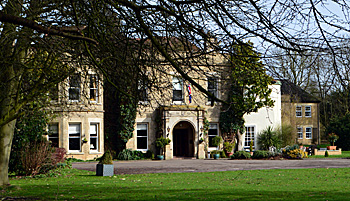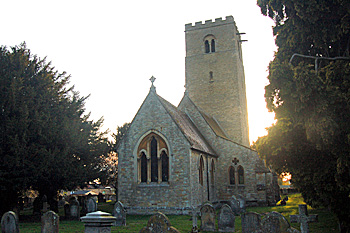A Strange Exhumation in Clapham

Woodlands Manor March 2017
John Thomas Dawson died at Woodlands in 1850 and his son, Rev John Frederick Dawson inherited it. He was absentee parson of two parishes in Lincolnshire from 1827 to his death in 1870. He married Hester Wade-Gery in 1827. She died in 1860, aged 56, and he then married his housekeeper Alice Procter, their son John Frederick was baptised at Clapham in 1864. He then moved away as in 1867 and 1868 Woodlands was let to a William Shilleto. After Dawson’s death in 1870 the louse was let to the Fitzpatrick family. The Bedfordshire Mercury carried a curious article in its edition of 30th September 1876.
“An unexpected and fruitful topic of conversation has been supplied to the villagers of Clapham, and to the good people of Bedford, by a singular search which was conducted at the former place on Tuesday last [26th September]. The search was for a will supposed to have been made many years since, and which affects the ownership of a valuable and pretty estate in the parish, known as The Woodlands. It appears that in 1812 the estate of Woodlands, which consists of a comfortable family residence, and picturesque park and grounds, situate on the east side of the Bedford road, at the entrance to the village, was purchased by Mr John Dawson, a gentleman formerly living in Bedford. After residing upon his property for some years, Mr Dawson died intestate and a Mr John Frederick Dawson, a gentleman in holy orders and possessing the distinction of LL.B [Bachelor of Laws], succeeded to the estate. At the time a rumour gained circulation that the former possessor, some time previous to his death, executed a will, under which succession to the estate was settled upon the principle of primogeniture. However, an heir in the direct line was not wanting, for the Rev J F Dawson was twice married, having issue by his first wife one son only, who now survives. By his second wife, a lady who still lives and is much respected, he had one son and one daughter; but in defiance of the provisions of the former will, if such was made, or in ignorance of its existence, the Rev J F Dawson left the estate, under trustees, to his second son, making ample provision for his widow and daughter. This disposition of the property, which became known after his death in October 1870, of course, gave a heightened interest to the rumour as to the existence of a former will. A most diligent search was made , but no trace of it could be found, and the matter would probably have remained in abeyance but for a statement that has lately been going the round of gossip to the effect that some documents were placed in the coffin of the Rev J F Dawson just before its removal for interment. The carpenter who had screwed down the lids averred that previous to this being done the nurse who had attended the deceased in his last illness placed under his body a bundle of documents tied with red tape. In this way an impression got abroad that the supposed will of entail had been buried with the Rev J F Dawson. It was a probability which the son by the first marriage could not afford to disregard, and application was therefore made by his legal representatives to the Home Secretary for leave to exhume the body. The necessary permission was obtained and the operation conducted on Tuesday morning last”.
“The utmost secrecy was observed with regard to the unusual proceeding, and every precaution taken that none but those immediately concerned should know of the occurrence. The police of course were acquainted, intimation having been sent by the Home Secretary, and Superintendent Kennedy and three constables of the Bedford division were in attendance and remained during the whole proceedings. To the churchwardens of the parish was not known till the following day, but the Vicar had to be entrusted with the secret, as through him the keys of the church, which were required, had to be obtained. The tradesman employed in raising the coffin was Mr Wade, a stonemason of Saint Neots, who, with four labourers, arrived on the scene about twenty minutes to two on Tuesday morning. A second carriage conveyed some legal gentlemen, Mr Day and Mr Wade-Gery, Mr Dawson the claimant under the supposed will, and a medical gentleman from Hertford; Mr Halliley, of Bedford, was also present as representing the trustees. The grave of the deceased gentleman is situated in the eastern corner of the churchyard, is bricked and covered by a large inscribed stone slab of about a ton weight. The night was most favourable to the occasion, being exceedingly dark and not at all cold. The secret had been carefully kept for no one but those concerned were present. As despatch was necessary, the lanterns were at once lighted and the work commenced. The removal of the stone was a work of great difficulty, and occupied some considerable time before the earth could be taken out. It was thought that the coffin would be found about four feet from the surface, and that depth was reached and anther foot of earth removed, and it still remained uncovered. Two feet more of earth were shovelled out, and then a stone on the coffin was seen. It was then daybreak, and a few labourers, who were passing to their work, were attracted to the spot. Another person, having seen earlier a number of men working in the churchyard by the light of the lanterns, not unnaturally came to the conclusion that a party of body snatchers was at work. As may be imagined, as this became circulated a large number of persons soon gathered in the churchyard, but satisfied by the presence of the police that no such outrage was being perpetrated, they conducted themselves with the utmost decorum while awaiting the progress of events. By seven o’clock the coffin was brought to the surface and placed upon planks resting over the grave”.
“It was an oak coffin, very little decayed, while the plate bearing the age and name of deceased, with the date of his death, and the brass handles, were as perfect as when placed in the ground six years ago. The outer coffin of oak contained an inner one of elm, and a diligent search was made for any documents between the two receptacles, but without result. This inner shell was then opened and the body exposed to view. It was covered with a substance which appeared to be sawdust, and was in a wonderful state of preservation, the features being distinctly traceable; and thanks to a proper supply of disinfectants not the slightest smell was perceptible. The sawdust contained no paper of any kind but, on lifting the body, a bundle tied round with red tape was discovered. This was placed between the left side and arm, and appeared to be a bundle of letters, but in a very sodden condition, so that their contents could not at the time be read. They were, however, placed in a box and sealed by the representatives of the parties concerned, and taken possession of by the gentleman from Hertford, until a day is arranged by the parties for their examination”.
“We are informed that no parchment, or any document that might prove to be a will was found, and we believe that Mrs Dawson herself has stated that there was nothing in the bundle, but a number of letters which passed between the deceased and his first wife, and which at his request were placed in the coffin. At the foot of the deceased’s coffin was found a soft felt hat and a silk gown. The search having been concluded, the body was replaced as quickly as possible, and the coffin restored to the grave which was soon after filled in and the top stone placed in its old position. By twelve o’clock the workmen had concluded their labours, but for some time afterwards a number of persons remained in the churchyard discussing the event. Several also arrived from Bedford, where the news of the affair had caused much conversation and excitement”.

The church from the north-east at sunset April 2010